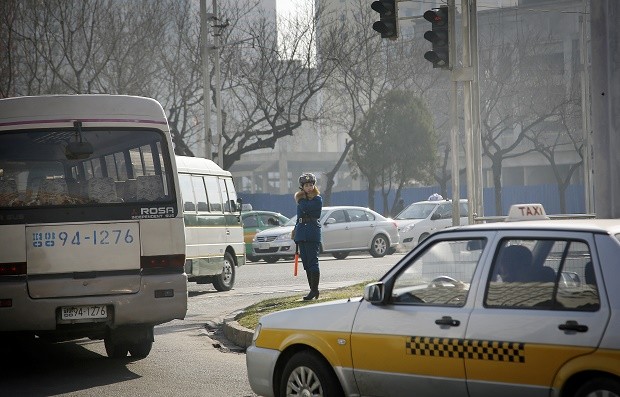
In this Dec. 1, 2015, photo, a North Korean traffic police officer directs traffic in Pyongyang, North Korea. Traffic in North Korea’s capital has gotten visibly heavier over the past year or so, with more trucks, taxis, passenger cars and other vehicles plying the streets and giving the often empty-seeming city of roughly 2.5 million a more lively look. AP
PYONGYANG, North Korea — The once sleepy streets of Pyongyang, where the city’s iconic traffic controllers would stand in the middle of usually deserted intersections to direct what few cars came by, are now looking a lot busier. So much so, in fact, that a new word has entered the North Korean lexicon — “jam,” as in traffic jam.
Traffic in North Korea’s capital has gotten visibly heavier over the past year or so, with more trucks, taxis, passenger cars and other vehicles plying the streets and giving the often empty-seeming city of roughly 2.5 million a much more lively look.
To be clear, Los Angeles or Jakarta it is not.
Even with more vehicles on the roads, it’s unusual to have more than a dozen or so cars waiting behind a red light at any time of day, in any part of the city. At night, the roads remain virtually empty. Most residents still get around on foot, pedal their way around town on bicycles — Pyongyang also got its first cycling lanes this year — or use public transportation. Unlike any other city in North Korea, Pyongyang has a subway system.
READ: N. Korea wins back pride in ‘kimchi war’ with South
What’s driving the increase in traffic in Pyongyang, like many things about North Korea, is something of a mystery. Obtaining official figures on vehicle numbers in North Korea is virtually impossible given the opaque nature of the government bureaucracy.
But the trend does seem to jibe with an increase in construction going back about five years, which has meant more trucks are on the road to deliver workers and building materials, and the spread of entrepreneurial-style businesses that have the backing of state-run organizations. Such businesses could be generating the kind of profits needed for their mother organizations and their own managers or workers to use automobiles.
Pyongyang streets continue to be dominated by trolleys, buses, cargo-carrying trucks and the official vehicles of the military, government or party elites. And while the number of taxis has swelled over the past few years, they are still probably in the 1,000-plus range. It remains exceptionally rare for any North Korean to have a car that is strictly for personal use.
READ: UN chief will try to visit North Korea as soon as possible
Most passenger cars are either overtly from China or brought in from China and then given some final assembly touches and rebranded with local markings. North Korea only has one domestic automaker, Pyonghwa Motors, and its production output is believed to be very low.
Nevertheless, the ripple effects from the growth in traffic — and efforts to deal with it — are beginning to stand out.
For one, the number of traffic lights has been steadily increasing, though they probably don’t pose much of a threat to the traffic controllers, who are mostly young women and whose ubiquitous presence and bright uniforms that change with each season have long made them a symbol of the capital.
Parking lots, including the one at Pyongyang’s new airport, that charge hourly fees are also springing up all over the city. Lots outside some department stores are now charging fees and so are attendants in the parking area outside the popular Tong’il market, a bazaar-like spot off-limits to most foreigners but normally crowded with locals and diplomats.
It’s also gotten a lot easier to find a gas station, even outside the city.
Though paying for gas is a big hurdle to car ownership, the price has reportedly gone down recently. At one Pyongyang gas station last week, the price for one kilogram of gas — instead of liters, that’s the most commonly used unit — was 73.33 North Korean won, or 80.06 won if purchased with a debit card. Diesel costs 63.33 won.
At the official exchange rate, that is less than one US dollar.

